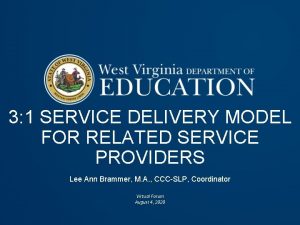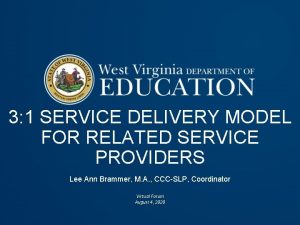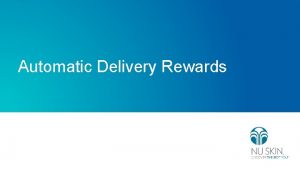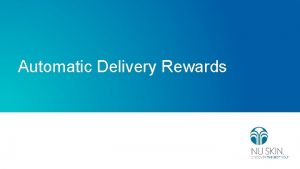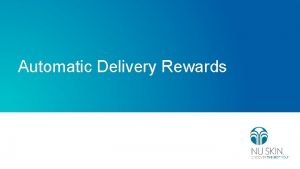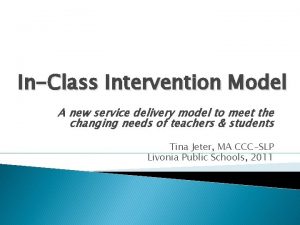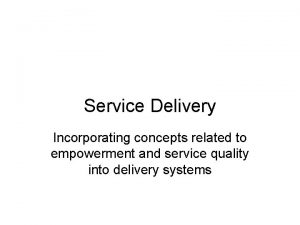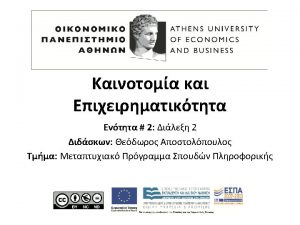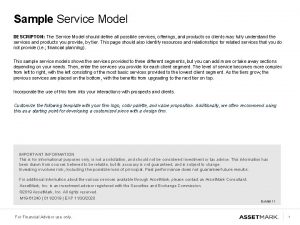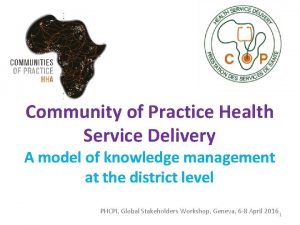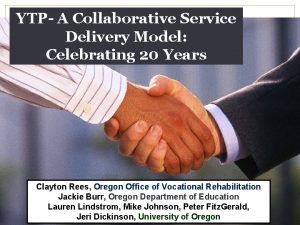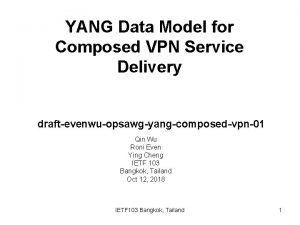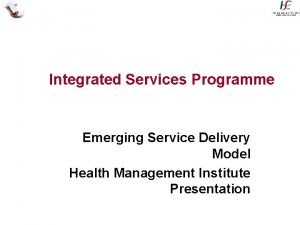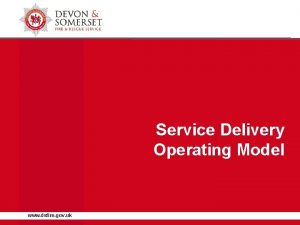3 1 SERVICE DELIVERY MODEL FOR RELATED SERVICE















































- Slides: 47

3: 1 SERVICE DELIVERY MODEL FOR RELATED SERVICE PROVIDERS Lee Ann Brammer, M. A. , CCC-SLP, Coordinator Virtual Forum August 4, 2020

WELCOME! • Please mute your microphone and turn off your camera • Close captioning is available via the toolbar • Ask questions by using the chat box or your microphone • Register to receive non-degree graduate credit for certificate renewal at https: //wveis. k 12. wv. us/registration/ 2

FINANCIAL DISCLOSURE Ms. Brammer is employed by the West Virginia Department of Education. There are no other relevant financial relationships to disclose. We received approval from the West Virginia Board of Examiner’s for Speech-Language Pathology and Audiology for this session. We applied to the West Virginia Physical Therapy Board. 3

LEARNER OUTCOMES • Participants will be able to discuss five positive effects of using the 3: 1 Scheduling Model. • Participants will be able to name five indirect activities that can be done during the indirect week of therapy. (In 2014, the American Speech and Hearing Association (ASHA), the American Physical Therapy Association (APTA) and the American Occupational Therapy Association (AOTA) endorsed a paradigm shift to a workload model in educational settings. ) 4

WHY IS IT IMPORTANT TO DISCUSS THE 3: 1 (COMPLIANCE OR FLEXIBLE) SCHEDULING MODEL With our jobs, flexibility is ALWAYS important! 5

WVDE PUBLIC SCHOOL RE-ENTRY MODELS FOR FAMILIES https: //wvde. us/school-system-re-entry/ 6

SCHEDULING 7

EVIDENCE-BASED RESEARCH “Little evidence suggests that two half-hour sessions weekly promote student’s ability to acquire and generalize speech or language skills, yet this option is typically chosen by teams that develop the Individualized Education Program (IEP). In a systematic review of research on school service delivery models, Cirrin et al. (2010) found that in many instances classroom-based services were at least as effective—if not more effective—in helping students to meet speech-language objectives. ” 2010) (Flynn, ASHA Leader 8

EVIDENCE-BASED RESEARCH (Continued) There is research on the effects of collaborative services. It is important to plan with the teachers in order for it to be effective. (The Informed SLP) 9

HOW IS THE 3: 1 MODEL SCHEDULING MODEL DIFFERENT FROM A TRADITIONAL SCHEDULING MODEL? A traditional schedule provides for direct therapy a number of times per week for four weeks. There is no time to do indirect activities in the schedule because sessions are scheduled every half an hour. The 3: 1 (Compliance or Flexible) Scheduling Model provides for three weeks of direct services and one week of indirect. The focus of the direct weeks is on learning new skills. The focus on the second week is monitoring stabilization of skills. 10

WHAT IS THE 3: 1 SCHEDULING MODEL? • The 3: 1 model is an example of a cyclical schedule. Direct services are conducted for 3 weeks in a row, followed by indirect services and activities in the 4 th week. • IEPS reflect the service frequency (e. g. , [direct service × minutes 3×/month] + [indirect services × minutes 1×/month]). Some counties are choosing not to put the indirect services on the IEP. • The week of indirect services could be referred to as a "student support week" to document that services are still being provided during that week. (ASHA Practice Portal School-Based Service Delivery in Speech-Language Pathology) 11

WHAT IS THE 3: 1 SCHEDULING MODEL? (Continued) The 3: 1 Model is a flexible scheduling option, utilizing a workload approach to speech and language services in which three weeks out of each month are primarily designated for direct intervention with students, and one week is set aside for indirect services. The indirect week does not have to be the 4 th week, although that may be the logical option in most cases. (Mount, 2017) In some cases, the indirect activity days are spread throughout the month but are equivalent to a week of time. (Schroeder, 2019) 12

3: 1 MODEL PROVIDES THERAPIST WITH: “A distinct structure to formally discuss student needs, progress and strategies needed for success that can be consistently documented on a regular basis. ” (Mount, 2017) 13

PRIMARY GOAL OF THE 3: 1 (COMPLIANCE OR FLEXIBLE) SCHEDULING MODEL Primary: • To move toward aligning goals and objectives with the curriculum for better generalization of skills INTO the educational setting in which the student currently resides. Secondary: • Allows for a means to schedule indirect service time, which the traditional schedules do not. • Provides time for make-up therapy which results in more compliant IEP service delivery. 14

OUR WORKLOAD • Indirect activities that support students in the least restrictive environment (LRE) and in the general education curriculum • Direct services to students, including instruction, intervention, evaluation • Indirect services that support students’ overall educational program • Activities that support compliance with federal, state and local mandates and activities that result from membership in a community of educators Guide) (ASHA, Implementation 15

INDIRECT WEEK ACTIVITIES 16

INDIRECT WEEK ACTIVITIES 17

IPP--INTERPROFESSIONAL PRACTICE ACTIVITIES IPP occurs when multiple service providers from different professional backgrounds provide comprehensive health or education services by working with individuals, their families, caregivers, and communities to deliver the highest quality of care across settings. (ASHA) 18

INTERPROFESSIONAL COLLABORATIVE PRACTICE (IPP) In a large study, Pfeiffer, et. al. looked at school SLP’s use of IPP • SLPs most often engaged in IPP during IEP meetings (43% of SLPs), while using IPP in evaluation and treatment was less common (8% and 14% of SLPs, respectively). • SLPs were more likely to use IPP if they received interprofessional education training, had more years of experience, or worked in elementary (vs. secondary) schools. • SLPs reported that a lack of time, buy-in from other professionals, and administrative support stopped them from using IPP. (Informed SLP) 19

BENEFITS OF IPP ACTIVITIES • Allows for better generalization of student skills • Allows for more consistent student progress over time • Allows the SLP numerous opportunities to train staff on how to differentiate instruction (most learn by doing!) • Allows SLP to use a variety of learning modalities • Allows SLP to add to a teacher’s resource library • Allows for team-building opportunities • Allows the SLP to gain valuable knowledge of the curriculum • Allows the SLP to gain understanding of the classroom expectations for students we serve within the educational environment • Allows us to educate and demonstrate the value of what we do! (Campbell, 1999) 20

STUDENT NEEDS DICTATE SERVICES Think: Least restrictive environment Natural learning environment Impact on learning success Educational Relevance (Mount, 2017) 21

THE INDIRECT SERVICE WEEK • • It is usually the busiest week of the month It is your chance to see students in their learning environments SLPs can give feedback/ideas to classroom teachers SLPs can adjust speech/language programming to better meet student needs & to align with curriculum (engineered classrooms) • It is a student’s chance to see us outside of the speech room. Helps them remember to carry-over skills because we “are watching” • Allows for collaboration/consultation time with other speech pathologists, teachers, and other service providers • Allows time to develop home programs and track progress at home (Mount, 2017) 22

BENEFITS OF THE 3: 1 MODEL • Make-up therapy is easier to schedule so IEP’s are more compliant • Scheduling IEP’s during indirect week means less cancellation of therapy • Allows for the time to collaborate and plan with the teacher (IPP) • Frees up time to do everything that is required of us to meet the needs of our students (programming devices, home programs, etc. ) 23

DOES THE 3: 1 MODEL WORK Some of the benefits that SLPS all over the country report include: • Improved quality of services • Fewer SLP vacancies • Reduced litigation because IEP are being met • Increased opportunities for collaboration • Significant reduction in the SLP taking work home • Fewer direct-service cancellations • Increased ability to integrate IEP goals with the classroom curriculum (Schroeder, 2019) 24

WHY SHOULD I SHOW THE INDIRECT TIME USING THE 3: 1 SCHEDULING MODEL? Pros • Proves to parents you are doing the indirect services • Provides a way to document the services you are providing • Proves to principal and other staff that you have activities to do during the indirect week or days • Allows the important time necessary to collaborate with the teachers and other related service providers Cons • Documentation is required • Service must be provided 25

CLASSROOM CARRYOVER Promoted in Two Ways with the 3: 1 (Compliance or Flexible) Scheduling Model 1. SLP can be in the classroom targeting carryover and generalization directly – articulation, language, voice, fluency, social pragmatics. 2. SLP can collaborate with the teacher to develop supports for each student in the classroom to increase carryover and generalization of skills. A traditional schedule does not allow time for this carryover. (Rayburn-Kirk, 2015) 26

HOW TO WRITE THE SERVICES For Integrated In-Class Therapy (Push-In) • Speech-Language Therapy, 30 minutes per month, Indirect • Speech-Language Therapy, 90 minutes per month, GEE, Direct (Integrated in class) For Pullout Therapy • Occupational Therapy, 30 minutes per month, GEE, Indirect • Occupational Therapy, 90 minutes per month, SEE, Direct For Combination Therapy • Physical Therapy, 30 minutes per month, GEE, Indirect • Physical Therapy, 45 minutes per month, SEE, Direct (Pullout) • Physical Therapy, 45 minutes per month, GEE, Direct (Integrated in class) 27

IDEAS FOR MAKING THE 3: 1 SERVICE SCHEDULING MODEL WORK • Develop a schedule at the beginning of the year • Take a broader view of allocating your time (multiple students) • Be visible in classrooms and document all of your time • Students understand “coach” week better the indirect service week • A way to transition to more in-class service delivery or prevention 28

COLLEAGUE INVOLVEMENT SUGGESTIONS • Have a sign up sheet for collaborative teacher meetings during your indirect services week, so they feel like they have a say/stake in meeting with you • Have scheduled teacher collaborative sessions during the indirect services week (plan ahead and schedule these BEFORE that week begins). Be kind to your teachers and don’t “drop in” to meet • Have established observation times PER grade level already established prior to your indirect services week (things come up, so give yourself a window of time for those) • Have a schedule that you can post/share with others. Transparency is crucial, particularly when you are just getting started – don’t post student names • Call it what it IS – explanation of what you do is crucial • Have a schedule and STICK TO IT • Do not allow others (or you) to interrupt the work that is scheduled 29

IS THE 3: 1 (COMPLIANCE OR FLEXIBLE) SCHEDULING MODEL APPROPRIATE FOR ALL STUDENTS? The simple answer is, “No. ” Let’s brainstorm some reasons why. 30

DIRECT VS. INDIRECT SERVICES Direct • Evaluate students for eligibility for special education – this is going to take more time • Identify students with speech and language impairment • Provide direct intervention to students using a continuum of service delivery options • Provide direct services to students within the confines of MTSS (e. g. , RTI or STEPS) • Reevaluate students to determine whether continued services are needed Indirect • Analyze demands of the curriculum and its effects on students • Contribute to the development of IEPs, IFSPs, and 504 plans • Monitor implementation of IEP modifications • Design and program high-, medium-, and low-tech augmentative and alternative communication (AAC) systems • Update and train staff in the use of AAC materials and devices • Design curriculum modifications • Provide staff development to school staff, parents, and others • Provide training to interpreters • Provide training and oversight to SLPAs and otherapy extenders 31

WHEN DO YOU DO ALL OF THE INDIRECT ACTIVITIES USING A TRADITIONAL SCHEDULE? 32

WHEN BEGINNING THE 3: 1 MODEL Do’s • Have things written on your schedule for the indirect week of therapy • Share your indirect week schedule with other service providers and post it on your door so school staff can see that you have tasks that you’re doing • Collaborate to schedule indirect weeks at the beginning of the year – can schedule IEP Meetings, PLC’s, Grade Level Meetings • Make sure to work ahead to get testing finished • Spend teacher time wisely – discuss specific students, grade level learning targets and concerns • Be visible during the indirect week • Document what you do during the indirect week in order to be able to prove how you are using that time Dont’s • Don’t present the 3: 1 Model as having a “week off. ” It’s far from that. • Leave your indirect week schedule blank – have preplanned activities that will take place during that week, but be ready to be flexible in case you have evaluations to complete or other unanticipated issues 33

SAMPLE SCHEDULE 34

SAMPLE SCHEDULE 35

THINGS TO REMEMBER WHEN USING THE 3: 1 MODEL FOR OFFICE OF FEDERAL PROGRAMS MONITORING • It is suggested that you use two schedules to keep the Direct Weekly Schedule separate from the Indirect Week Schedule • Only list student’s names on the Direct Weekly Schedule the number of times you see them for direct therapy according to their IEP • If a student is seen for four weeks because they are not a candidate for the 3: 1 Model, then their name should go on the Indirect Week Schedule as well. • If you have Indirect Services listed for a student, then their name should go on the Indirect Week Schedule, too, for the amount of indirect minutes on their IEP. Guidance is to divide the total amount by four to have the indirect time listed on the Indirect Week Schedule. For instance, 20 minutes per month for indirect would be 5 minutes on the Indirect Week Schedule. 36

THINGS TO REMEMBER ABOUT OFFICE OF FEDERAL PROGRAMS MONITORING • They will ask for your schedule – just your regularly planned schedule, without notes about absences and make-up sessions • They will compare your schedule to the student’s IEP and make sure they have the correct amount of minutes on your schedule (direct and indirect) • You will show them your Schedule as if everything is perfect – like a teacher’s lesson plans • They don’t have to know who missed a session or who needs a make-up session – those notes will go on your daily therapy logs 37

PEOPLE WHO ARE USING IT • Melanie Place, Lead SLP, Berkeley County Schools – The Speech Place • Ashley Suddath, Lead SLP, West Virginia Schools for the Deaf and Blind – Visual Phonics Trainer • Ashley Carney, Lead SLP, Jefferson County Schools • Renée Roark and Hollie Cochran, SLPs, Raleigh County Schools Members of our 3: 1 Compliance Model Committee 38

CHALLENGE YOURSELF 39

QUESTIONS/CONCERNS 40

SURVEY Must be completed by 5: 00 p. m. the day of this session. Remember this is how your attendance is documented. https: //forms. office. com/Pages/Response. Page. aspx? id=S 7 AZ 4 Awzeka. Lrgn 7 Fzd. Nap. EOszzk 9 RJg. S 7 C 6 clj. CXd. UMVc 3 VUoy. S 1 cx. MDRGWVZRMTMz. Mk. Ja TVU 5 MC 4 u 41

CONTACT INFORMATION Lee Ann Brammer, M. A. , CCC- SLP, Coordinator lbrammer@k 12. wv. us 304. 546. 6623 (cell) 304. 558. 2696 (office) 42

RESOURCES ASHA. (2016). 2016 Schools Survey Report. Retrieved from http: //www. asha. org/Research/memberdata/Schools. Survey/ ASHA. (2010). Roles and responsibilities of speech-language pathologists in schools [Professional issues statement]. Retrieved from http: //www. asha. org/policy. https: //doi. org/10. 1044/policy. PI 201000317 ASHA. (2002). A workload analysis approach for establishing speechlanguage caseload standards in the schools: guidelines [Guidelines]. Retrieved from https: //www. asha. org 43

RESOURCES ASHA Practice Portal for School-Based Service Delivery ASHA. Interprofessional Education/Interprofessional Practice (IPE/IPP) https: //www. asha. org/Practice/Interprofessional-Education. Practice/ ASHAWIRE – “The 3: 1 Model – One of Many Workload Solutions to Improve Student’s Success, ” Tracy Schreader, M. S. , CCC-SLP, May 1, 2019. Pfeiffer, D. L. , Pavelko, S. L. , Hahs-Vaughn, D. L. , & Dudding, C. C. (2019). A national survey of speech–language pathologists’ engagement in interprofessional collaborative practice in schools: Identifying predictive factors and barriers to implementation. Language, Speech, and Hearing Services in Schools. doi: 10. 1044/2019_LSHSS-18 -0100 44

RESOURCES Cirrin, F. , Schooling, T. , Nelson, N. , Diehl, S. Flynn, P. , Staskowski, M. Adamczyk, D. (2010). Evidence-based systematic review: Effects of different service delivery models on communication outcomes for elementary school-age children. Language, Speech, and Hearing Services in Schools, 41, 233– 264. Retrieved from http: //lshss. pubs. asha. org/article. aspx? articleid=1779326 Lancia, J. , Nobel, G. , Sweeney, Sean. 2009. 25+ Strategies to Make 3: 1 Service Delivery Work for You. ASHA Presentation. https: //www. asha. org/events/convention/handouts/2009/2343_sweene y_sean/25+ 45

RESOURCES Montgomery, J. , & Moore, B. (2017). Making a difference for American's children: Speech-language pathologists in public schools (3 rd ed. ). PRO-ED. Mount, M. (2017, June). Promoting the 3: 1 Caseload Model Effectively. Speech Pathology. com, Article 8004. Retrieved from: http: //www. speechpathology. com Mount, M. (2017, August). Service Delivery: Thinking Outside the Box. Speech. Pathology. com, Article 19320. Retrieved from: http: //www. speechpathology. com. 46

RESOURCES “ 3: 1 Flexible Service Delivery Model, ” 07/26/15, Jenna Rayburn-Kirk, https: //thespeechroomnews. com/2015/07/31 -flexible-service-deliverymodel. html “ 3: 1 Service Delivery Model, ” Deborah Adamczyk, M. A. , CCC-SLP, Speech Pathology, 10/26/09. “What Are the Priorities that Motivated Me to Try the 3: 1 Model? ”, Boothby Therapy Services, 2014. “Interprofessional Collaborative Practice is Rare in Schools, ” Informed SLP, September 14, 2019. 47
 What are the two types of physical components
What are the two types of physical components Health-related
Health-related Human service delivery system
Human service delivery system Push-in service delivery model
Push-in service delivery model Improving hr service delivery
Improving hr service delivery Accenture delivery tools used for reporting purpose
Accenture delivery tools used for reporting purpose Kontinuitetshantering
Kontinuitetshantering Typiska novell drag
Typiska novell drag Tack för att ni lyssnade bild
Tack för att ni lyssnade bild Ekologiskt fotavtryck
Ekologiskt fotavtryck Varför kallas perioden 1918-1939 för mellankrigstiden
Varför kallas perioden 1918-1939 för mellankrigstiden En lathund för arbete med kontinuitetshantering
En lathund för arbete med kontinuitetshantering Personalliggare bygg undantag
Personalliggare bygg undantag Vilotidsbok
Vilotidsbok A gastrica
A gastrica Vad är densitet
Vad är densitet Datorkunskap för nybörjare
Datorkunskap för nybörjare Boverket ka
Boverket ka Mall debattartikel
Mall debattartikel Magnetsjukhus
Magnetsjukhus Nyckelkompetenser för livslångt lärande
Nyckelkompetenser för livslångt lärande Påbyggnader för flakfordon
Påbyggnader för flakfordon Formel för lufttryck
Formel för lufttryck Publik sektor
Publik sektor Jag har nigit för nymånens skära
Jag har nigit för nymånens skära Presentera för publik crossboss
Presentera för publik crossboss Jiddisch
Jiddisch Kanaans land
Kanaans land Klassificeringsstruktur för kommunala verksamheter
Klassificeringsstruktur för kommunala verksamheter Epiteltyper
Epiteltyper Claes martinsson
Claes martinsson Centrum för kunskap och säkerhet
Centrum för kunskap och säkerhet Programskede byggprocessen
Programskede byggprocessen Bra mat för unga idrottare
Bra mat för unga idrottare Verktyg för automatisering av utbetalningar
Verktyg för automatisering av utbetalningar Rutin för avvikelsehantering
Rutin för avvikelsehantering Smärtskolan kunskap för livet
Smärtskolan kunskap för livet Ministerstyre för och nackdelar
Ministerstyre för och nackdelar Tack för att ni har lyssnat
Tack för att ni har lyssnat Mall för referat
Mall för referat Redogör för vad psykologi är
Redogör för vad psykologi är Stål för stötfångarsystem
Stål för stötfångarsystem Tack för att ni har lyssnat
Tack för att ni har lyssnat Borra hål för knoppar
Borra hål för knoppar Orubbliga rättigheter
Orubbliga rättigheter Stickprovsvariansen
Stickprovsvariansen Tack för att ni har lyssnat
Tack för att ni har lyssnat Steg för steg rita
Steg för steg rita



